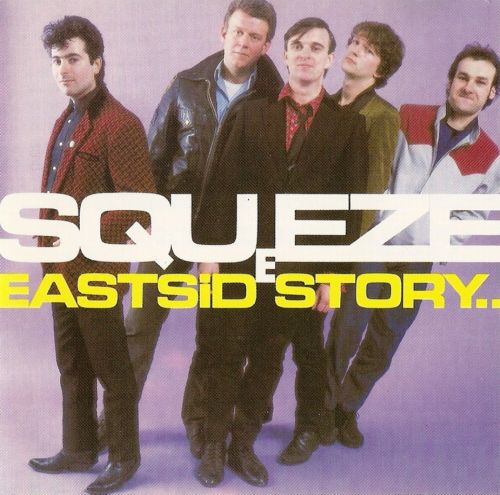

EAC FLAC -8
East Side Story is the fourth studio album by New Wave group Squeeze. The initial concept was for a double-LP with one side produced by Elvis Costello, another by Dave Edmunds, a third by Nick Lowe and the fourth possibly by Paul McCartney. Ultimately it was largely produced by Costello and Roger Bechirian, and released on one disc.
The album was a definite break with Squeeze's "New Wave" sound, as it contained songs influenced by rockabilly, R&B, blue-eyed soul, Merseybeat, and psychedelia among other genres. It also contained Squeeze's last top 10 UK single, "Labelled With Love". This was a track that Costello allegedly had to fight to have recorded, as Tilbrook in particular initially felt that the song was too country-and-western sounding for Squeeze's image.
East Side Story was the first album for new keyboardist Paul Carrack. He would sing lead on the track "Tempted", which became one of Squeeze's best-known songs, and Squeeze's first U.S. chart hit. Shortly after the release of this album, Carrack would leave the band for a solo career, but he returned to Squeeze for a time in the early 1990s, playing and singing on the Some Fantastic Place album.
John Bentley – bass, backing vocals
Paul Carrack – keyboards, vocals
Chris Difford – rhythm guitar, vocals
Gilson Lavis – drums
Glenn Tilbrook – lead guitar, keyboards, vocals
Additional Personnel:
Elvis Costello - vocals
Del Newman - string arrangements
Review by David Fricke (Rolling Stone #352, Sep 17, 1981):
http://www.rollingstone.com/artists/squeeze/albums/album/112132/review/6067920/east_side_story
In songwriters Glenn Tilbrook and Chris Difford, the British New Wave has finally found its own John Lennon and Paul McCartney. Given the fractious, hopelessly faddish nature of the current U.K. music scene, the honor certainly isn't what it used to be. In the wake of hipper pursuits like the New Romantics' Eurodisco fixation and the Promethean breast-beating of the Joy Division-Public Image Ltd. art-punk mob, Tilbrook and Difford – and with them, Squeeze – have been left holding the baton of English pop tradition practically by default, odds-on winners in an almost empty field.
It couldn't happen to two more qualified guys. Over the course of the first three Squeeze albums, Tilbrook has cultivated a talent for writing succinct, offbeat melodies shot through with classic Top Forty cheer. Difford possesses the gift of pithy lyrical gab, combining the epic sweep of Bruce Springsteen with the booby-trap wordplay of Elvis Costello. Plugged in with Squeeze, the two singer-guitarists pump up their songs with the boozy geniality of the Kinks and Rockpile, the Beatles' organic grace and the precision rock & roll drilling of Elvis Costello and the Attractions. Together, Tilbrook and Difford tell everyday stories of love's labors lost (occasionally found, too) with tragicomic poignancy and cinematic flair.
But where earlier LPs like Cool for Cats and last year's Argybargy were promising yet uneasy truces between pop savvy and punk clowning, East Side Story is Squeeze's finest hour. Produced with a sympathetic hand by Elvis Costello and Roger Bechirian (with Dave Edmunds at the helm for one cut), the new record offers a shotgun approach to pop stylization that hits nothing but bull's-eyes. Tilbrook and Difford take dead aim with tuneful wit and the intuitive aid of drummer Gilson Lavis, bassist John Bentley and new keyboard recruit Paul Carrack (who replaces cigar-chomping Jools Holland).
On side one alone, Squeeze frequent the lending library of 10cc (the lush barroom lament "There's No Tomorrow"), Booker T. and the MGs (the opening riff of "In Quintessence") and Roy Wood (the sitarlike banjo break in "Heaven"). But their compulsive borrowing is really a means to a personal end: it's the AM-radio bait that draws you into Difford's emotional underworld of bed hopping and bar crawling.
There's a twist of Lennon, for example, in Glenn Tilbrook's nasal tenor and the Rubber Soul-ful blend of guitars in "Is That Love." Yet such expert mimicry neatly camouflages the dramatic tension between Tilbrook's buoyant melody and the glib cynicism of Difford's argument with an errant lover. Similarly, the alcoholic C&W slumber of "Labelled with Love" underlines Difford's teary story about a woman who turns to the bottle after her husband dies by it.
While Chris Difford's specialty is capturing the essence of a relationship in small details ("I love to play her favorite country songs/With one or two chords always going wrong"), Tilbrook treats the tunes as soundtracks to Difford's soap-opera scripts. The hectic pace and furtive secrecy of the lovers in "Piccadilly" is matched by the racy arrangement and the frenetic performance of the band. Difford's compassion for the neighborhood tease is spotlighted by the baroque "Eleanor Rigby"-style orchestral score. And, indeed, "pop music plays on the local radio" as Difford goes snooping through his lover's diary in "Someone Else's Heart," a stealthy, seductive number with a latter-day Zombies feel.
The only thing as impressive as the caliber of composition on East Side Story is the way Squeeze make the songs come alive. Paul Carrack's soulful crooning, a highlight of the blue-eyed R&B strut "Tempted," is a welcome addition to the unique harmony of Tilbrook's boyish whine and Difford's gritty basso profundo. There's no room for instrumental flash in the Tilbrook-Difford repertoire, but Carrack contributes tasty keyboard touches (his comping Farfisa organ in "Someone Else's Bell" and the spookily distorted piano of "Heaven") while the Lavis-Bentley rhythm section securely anchors each cut.
Time will tell if East Side Story is any kind of Revolver or Abbey Road. But with this album, Glenn Tilbrook and Chris Difford have at least proved themselves worthy of being mentioned in the same breath with John Lennon and Paul McCartney. They have a genuine respect for the past, an unflinching grip on the present and, one would hope, enough talent and imagination to transcend pop fashion in the future.